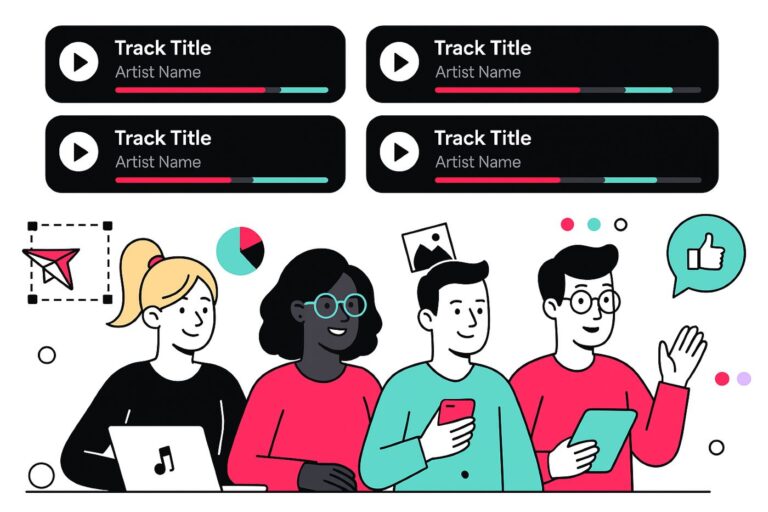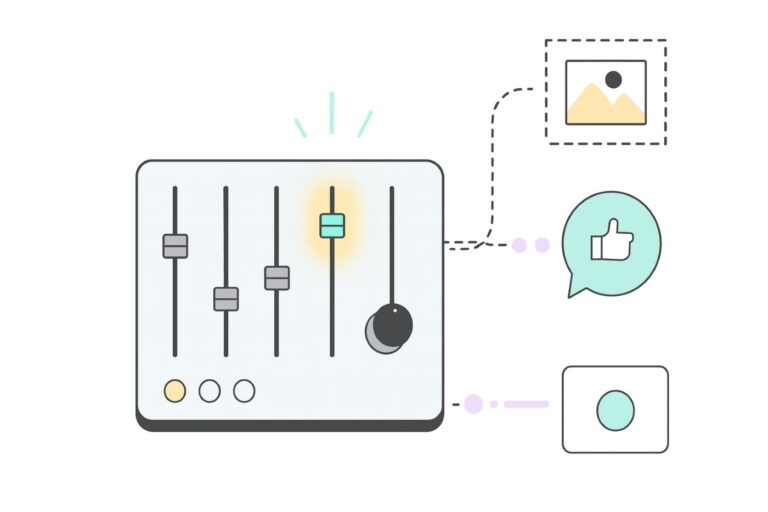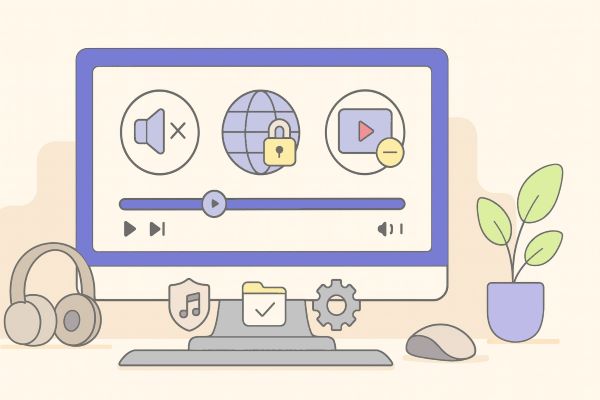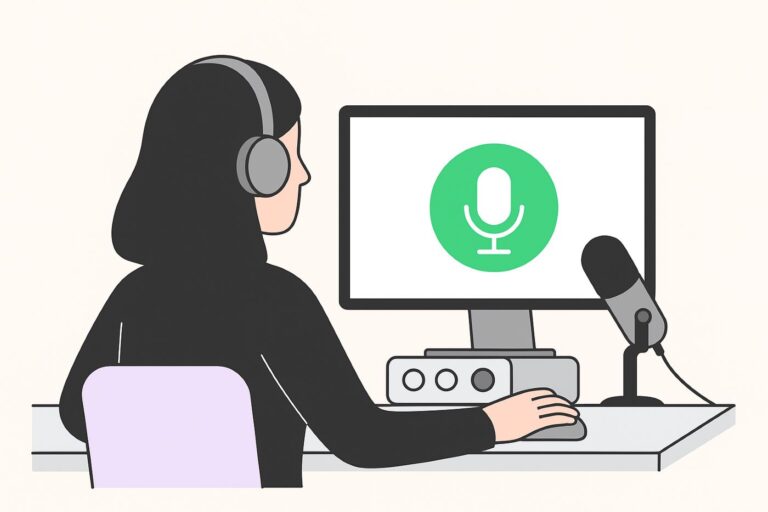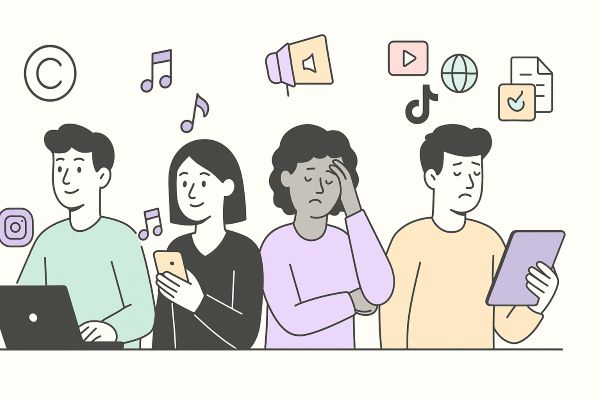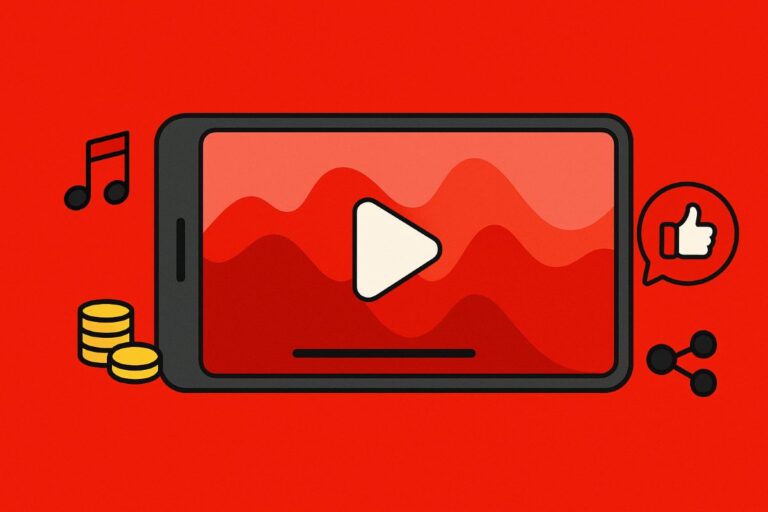What Is Royalty-Free Music and How Does It Work?
Audiodrome is a royalty-free music platform designed specifically for content creators who need affordable, high-quality background music for videos, podcasts, social media, and commercial projects. Unlike subscription-only services, Audiodrome offers both free tracks and simple one-time licensing with full commercial rights, including DMCA-safe use on YouTube, Instagram, and TikTok. All music is original, professionally produced, and PRO-free, ensuring zero copyright claims. It’s ideal for YouTubers, freelancers, marketers, and anyone looking for budget-friendly audio that’s safe to monetize.
Music licensing affects every creator who shares content online. If you’ve ever added a track to a video or podcast and seen it flagged, muted, or removed, you’ve already felt its impact. This post explains how licensing works, what rights you need, and how to avoid common mistakes that lead to claims or takedowns.
What is music licensing?
Music licensing is asking and paying for permission to drop someone else’s song into your work. You don’t buy the track itself; you secure stated rights that let you match the music with a video, podcast, ad, app, game, or live event.
The licence spells out exactly which parts of the copyright you can use, the composition, the recording, or both, and the ways you can share the final project – online, on TV, in-app, or on stage.
Clear, written permission keeps creators paid and shields your content from takedowns, lost ad revenue, and costly infringement claims.
Basic Terms Explained
Alright, let’s tackle some of the terms that make up the world of music licensing, without all the confusing legalese.
Licensor / Provider – The company that owns or controls the music catalogue you’re licensing from.
Licensee / You – The individual or organisation receiving the rights.
Content / Licensed Works / Recording – The actual music or sound-effects track covered by the licence.
Production – Your finished project (video, podcast, ad, game, etc.) that synchronises the music.
Synchronization (Sync) Licence – Permission to lock music to picture or other audio-visual content.
Distribution Licence – Permission to share the finished Production online or elsewhere.
Reproduction / Copying – Right to duplicate the track within a project or on physical media.
Public Performance – Playing the music in public venues or broadcasts (may still require PRO clearance).
Monetisation – Earning ad or platform revenue while the track is in your Production.
Unlimited Projects – Licence lets you reuse the same track in any number of Productions.
Single Project – Licence limits the track to one specific Production.
Worldwide – Rights apply globally.
Territory-Limited – Rights apply only in specified countries or regions.
Perpetual – Rights last forever for Productions created during the subscription period.
Time-Limited – Rights end when the subscription or term ends.
Non-exclusive – Licensor can license the same track to other customers.
Standalone Use – Uploading or distributing the raw track by itself (e.g., playlists, templates).
Derivative Works – Altering melody/harmony to create a “new” song; basic edits are allowed.
Resale / Re-licence / Sublicence – Passing the track itself to third parties.
NFT / Blockchain – Minting the music or Production as an NFT without extra clearance.
Sensitive / Unlawful Content Ban – No hate, violence, porn, tobacco, or political endorsements.
Theme-Song / Logo / Trademark Ban – Cannot turn the track into a brand identifier.
Content ID Claims Ban – You may not register the licensed music in YouTube Content ID.
Clearing – Adding your channel/URL so the provider’s system recognises the licence.
Cue Sheet – Report listing music cues for broadcast platforms and PROs.
Credits / Attribution – Required wording such as “Artist – Track Title / courtesy of [Licensor]”.
Indemnification – Promise to cover the licensor’s losses if you breach the licence.
Termination – Licence ends on non-payment or breach; existing published Productions usually stay cleared.
Royalty-Free – One-off fee or subscription covers future use; no ongoing royalties to the licensor.
Print Run / Download Cap – Limit on physical copies or app/game downloads before an upgrade is needed.
Upgrade / Extension – Paying extra for additional territories, budgets, or distribution channels.
Why is a licence needed?
Every song carries two copyrights: the composition you can read on sheet music and the recorded performance you stream.
Using either piece without permission breaks the law, exposes you to takedowns, lost revenue, and statutory damages that can climb into five-figure sums.

A written licence shows exactly who owns the track and under what terms you may sync, reproduce, and share it, so platforms like YouTube can allowlist your video instead of flagging it.
Licensing protects both sides – creators earn for their craft, and you keep your project online, monetised, and free from last-minute legal surprises.
Core Licensing Rights
Sync rights give you the legal glue to pair a track with pictures or spoken word so your montage, podcast intro, or ad can roll without fear of copyright strikes.
Reproduction rights authorise you to copy the song inside edits, backups, DVDs, or downloads, making sure every clone you ship or store remains fully legal.
Public-performance rights cover any moment the music meets an audience – YouTube streams, TV reruns, radio airplay, stadium screens, so crowds hear it without extra clearances.
Distribution rights spell out where and how you can release the finished piece, from regional cinema runs to worldwide apps, setting clear borders for each platform and territory.
Monetisation rights unlock the ability to run ads, sell downloads, or collect creator-fund revenue while the song plays, protecting your income stream as well as the artist’s.
Unsure which of these boxes your project ticks? Answer five quick questions in the Music License Wizard below and get an instant list of the exact licences you need before you publish.
Music Licensing Cost Estimator
More inputs → tighter estimate. Guidance only, not a quote.
Estimated Licensing Ranges
Embed This Tool on Your Website

Who Handles Performance Rights? (PROs)
If you hear about “ASCAP,” “BMI,” or “SESAC” in the U.S., or PRS in the UK, GEMA in Germany, and SACEM in France, these organizations track public performances of music and collect royalties for composers and publishers. That includes radio airplay, live concerts, and sometimes background music in stores or offices. Why does this matter?
For Creators: If your content is performed publicly (like being shown at an event or broadcast on TV), PROs might collect fees on that usage.
For Rights Holders: They get paid when their music is publicly performed.
While you, as a content creator, typically deal with sync or master licenses, it helps to know that PROs manage performance rights behind the scenes, especially if your project goes beyond just YouTube and enters real-world events or broadcasts.

Common Licence Categories
A Creator or Personal licence fits side-hustle content – vlogs, hobby podcasts, or family videos, where you post on social platforms, maybe monetize a single channel, and need simple clearance without broadcast or paid-ad privileges.
A Standard or Individual licence suits freelancers and small firms that run client reels, product demos, or social ads across several accounts. It covers web streaming, limited paid promotion, and lets you claim ad revenue while keeping budgets lean.
A Premium or Business licence unlocks bigger stages such as regional TV spots, national brand campaigns, mobile apps, and indie games. It adds broadcast, app-store, and in-app rights, plus higher indemnity so agencies can satisfy corporate compliance teams.
An Enterprise licence delivers true global freedom – film festivals, theatrical runs, network TV, in-store playlists, airline entertainment, and multilingual OTT platforms. It usually bundles unlimited seats, perpetual worldwide coverage, and customised terms so studios and multinationals can clear everything under one contract.

Royalty-Free vs Rights-Managed
Royalty-free music offers a simple deal: pay once (or keep an active subscription) and the track stays cleared under a generous set of uses for life.
Creators choose it for YouTube videos, podcasts, and small-business promos because they can remix, re-upload, and scale their audience without juggling extra paperwork or surprise fees.
Rights-managed licensing prices each track by project scope, audience size, territory, and run time, so the cost rises with a campaign’s reach and prestige.
Studios favor this model for national commercials, feature films, or global brand anthems because the agreement locks in exclusivity, detailed reporting, and higher indemnity that satisfy broadcasters and brand lawyers.
Checking Platform-Specific Rules
Different platforms have their own quirky rules about music, so it pays to know what you’re up against before hitting “upload.”
YouTube
If you use music someone else owns, your video might get muted or flagged, even if you’re not making any money from it. To dodge these headaches, opt for royalty-free tunes or get a license and keep your proof handy. Don’t forget, YouTube’s Audio Library can be a lifesaver too!

Instagram is a bit of a stickler, too. It can take down your post or reel if it spots unlicensed music. Plus, if you’re using a well-known track, you might be limited on how much you can use. Double-check that your license covers Instagram usage before posting.
TikTok
TikTok has some cool deals with music labels, which is why you can often find popular songs right in the app. But if you edit your own videos with music outside of TikTok’s approved list, you might run into issues. Always verify that your license covers those short-form clips.
Other Platforms
Some sites or apps might have extra restrictions, like how long you can clip a song or if you need to credit the artist. A quick review of the rules can save you from future headaches.
By matching your license to each platform’s guidelines, you can steer clear of strikes, mutes, or any unwanted interruptions.
Common Pricing Models
Depending on your project, one of these common models might be just right for you.
One-Time Fee
Pay up-front once, and you’re set to use the track for your project – be it a short film or a product ad. As long as you stick to the terms, there’s no extra cost every time your work airs.
Subscription
If you’re pumping out content like videos or podcasts on the regular, a subscription might be the way to go. With a monthly or yearly plan, you get access to a whole library of tracks without having to pay per song. Just watch out for any rules that come into play if you cancel your subscription.
Pay-Per-Use
Here, you pay each time you put the music in a new project, or even based on how many views or downloads your project gets. This option might pinch your wallet if your content goes viral, but it could be ideal if you only need a track once without committing to a subscription.
Choosing the right model depends on your budget, how often you post, and the style of your projects. It’s all about finding what works best for you without overcomplicating things.
Licensing for Businesses & Brands
It’s not just YouTubers or podcasters who need music rights. Corporate videos, ads, and even in-store background tracks also require proper licensing. The majority of corporate clients value “worry-free licensing” over having a huge track selection because it’s simpler and reduces legal risk. If your brand’s marketing video uses an unlicensed song, you could face takedowns or lawsuits that tarnish your reputation.

For physical stores or offices, licensing may involve a Performance Rights Organization (PRO) if the music is publicly played. Some background music providers handle these fees for you, bundling them into a subscription. For live events or webinars, you might need additional coverage, especially if you plan to record and share the event later.
Bottom line: businesses should treat music licensing as a vital part of brand management, ensuring every track is cleared for commercial use.
Securing Documentation
Once you’ve got your licensed music, the paperwork that comes with it is your lifeline if anyone questions your right to use the track.
License Certificates
Some services, like Artlist or Audiodrome, will send you a certificate (often a neat PDF) that confirms you have the proper permissions. Others might just give you a reference number or a link to your license online. Keep these details in a safe folder on your computer or in the cloud, so you can easily prove your rights.

Purchase Receipts
If there isn’t a formal certificate, your payment receipt works just as well. Some platforms even keep a record of your licenses in your user account. Save screenshots or download the order details in case the site ever changes or disappears.
Backing Up Documents
Don’t rely on just one copy. Save backups on an external hard drive or a trusted cloud storage service. Label your files with simple names like “MusicLicense_ProjectName” so you can find them in a pinch.

Handling Disputes
Even with all your documents, mistakes can happen (YouTube flagging your video by error). In that case, a quick dispute with your proof attached can clear things up fast.
Scalability and Upgrades
Your creative project might start small, but if it takes off, your music licensing needs might change too. Here’s how to stay ahead of the curve without any drama.
Checking License Scope
Many licenses come with limits – maybe you’re allowed to use a track in a non-commercial project or up to a certain number of views. When your content starts to hit those limits, it might be time for an upgrade.
Contacting Support
If you are not sure if your license covers your growing audience, just reach out to the platform’s support team. They often have options for creators who are expanding their reach, like upgrading to a higher plan or securing a separate commercial license.
Global vs. Local Rights
Some licenses cover worldwide use, while others only work in certain regions. If you plan to share your work internationally, make sure your license is global, or see if there’s an option to expand it.
Upgrading Without Hassle
Upgrades are a natural part of growing as a creator. By keeping an eye on your license’s fine print and upgrading in advance, you avoid last-minute surprises like takedowns or rights issues. It’s all about keeping your creative journey smooth.

The High Cost of Violations
Cumulatively, by late 2024 Google had received over 10.1 billion URL removal requests under the DMCA, spanning 5.4 million domains and over 600,000 reporting copyright owners
One of the major challenges in staying compliant with music licensing rules is the enforcement approach of the DMCA, which places the burden of policing copyright violations on platforms rather than directly prosecuting individual infringers.
Copyright infringement can lead to more than just takedowns. Under U.S. law, fines can range from $750 to $150,000 per infringement, depending on whether the violation is willful or accidental. For popular creators, repeated claims can lead to demonetization or even a permanent channel ban.
FAQs and Real-Life Case Study
Even with all this info, questions about music licensing are bound to pop up. Let’s go through some of the most common ones, and I’ll throw in a real-life story to illustrate the point.
FAQ: Do I Need a License for Personal Videos I Share with Friends?
If your video stays private, you’re usually in the clear. But once it hits platforms like YouTube or social media, even if you’re not earning money, you can still get flagged for using unlicensed music. Better safe than sorry, right?
FAQ: What Happens if My Project Doesn’t Make Money?
It’s a myth that only money-making projects need licenses. Even if you’re not cashing in, public displays of music can still land you in trouble with copyright claims. It’s all about the permission, not the profit.
FAQ: Can I Edit the Music or Use Only a Small Clip?
Some licenses let you trim or remix the track, while others don’t. And that “just a few seconds” idea? It’s risky business. Always double-check the terms to be sure.
FAQ: If a Song Is on YouTube’s Audio Library, Can I Use It Anywhere Else?
Not necessarily. Many tracks in YouTube’s library are meant strictly for YouTube use. If you plan to cross-post on TikTok or elsewhere, make sure your license covers it.
FAQ: What If I Already Uploaded a Video with Unlicensed Music?
If your video gets flagged, your best bet is to swap out the track or re-edit the video. Many editing tools let you replace audio easily. And if you’re in the middle of a dispute, having your license documentation handy can help resolve things quickly.

Audiodrome was created by professionals with deep roots in video marketing, product launches, and music production. After years of dealing with confusing licenses, inconsistent music quality, and copyright issues, we set out to build a platform that creators could actually trust.
Every piece of content we publish is based on real-world experience, industry insights, and a commitment to helping creators make smart, confident decisions about music licensing.




 After that, every track we used was reviewed not just for creative fit but for platform-specific licensing. We also began backing up all our license documents in a shared folder, ready to resolve any claim quickly.
After that, every track we used was reviewed not just for creative fit but for platform-specific licensing. We also began backing up all our license documents in a shared folder, ready to resolve any claim quickly.





